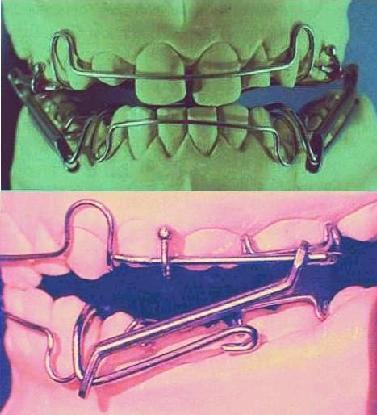
Bite jumper plates
Doing dental corrections and
bite shift simultaneously with these appliances allows time-efficient
therapy
even of older teenagers.
Jähnig´s
modern „Göttingen“ type is shown above, which is very
versatile and with high comfort. The mobile bite jumper yokes are
at the outsides. Inside, any kinds of springs and screws can be
included into the plates, for any further correction which is
desired. The plates are detachable, e.g. to wear one of them for
additional hours per day, if required. See
case example for
more.
For this kind of bite jumper plate, also a headgear
effect is reported. In contrast to the activator (see below), it acts more
on the upper than on the lower jaw. The forces along the yokes are
of similar size and direction to those of a high-pull headgear!
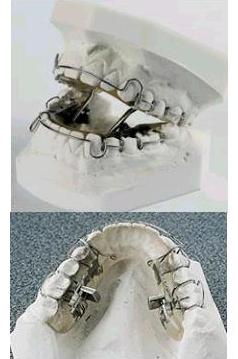
Double and single (lightweight) bite back-shift plate
Bite
back shift plates are intra-oral double-plate appliances to treat class
III (progenic) cases.
That means, they do the opposite of the before-mentioned bite
jumper plates, and this is more difficult: try yourself, how far
can you shift your lower jaw forward, but how far only pull it
backward?
Unfortunately, gentle methods of working with growth had vanished for
these patients (also one-piece appliances e.g. FR 3, Bimler C and Jaw Shapers, see all below), even if children show up well in
time. All these appliances keep not only the lower jaw back and
enhance the forward growth of the upper, but can also provide a simultaneous
upper expansion, which most of the progenic cases
require. The bite back shift plates use a common large
expansion screw for this.
The task of shifting back the lower jaw by small steps is solved here by the Sander-III RDP kit: in the upper plate, a pair of downward directed lateral rods, and in the lower a pair of lateral supports which keep the upper rods in front of them. See the RDP collage of views (pdf) of the blue specimen for all these details: viewed from the lower plate, this is held back by the upper plate. Some sideward distance permits for expansion. Now, the lower supports can be screwed forward, giving the lower plate and jaw a back-shift little by little, whereas the counter-force acts on the upper jaw.
The 4-element bite back shift single plate leaves more space for the tongue. As the first element of the shown pink specimen, a re-adjustable downward bow holds the lower jaw back (compare with „ expl. of cases“ > Early treatment of class III). Next, an expansion screw gains jaw width. For gain of frontal jaw length, protrusion springs push the incisors from inside, and the outer shields, somewhat small here, stem from the FR 3 (see below) and should stimulate the bone growth in the height of the roots.
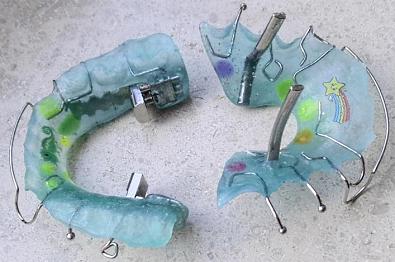
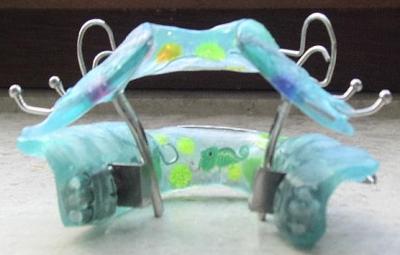
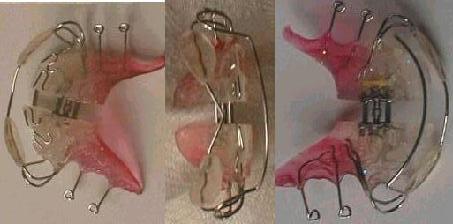
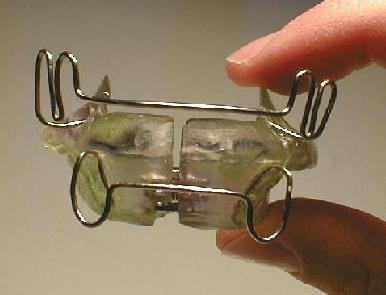
Well-shaped activator
The shown specimen reaches deep in the lower jaw, and snaps in there, for its sure guidance especially during sleep. In the upper jaw, however, the plastic body is largely reduced. By this, it hinders speech less than most upper plate appliances. It performs not only bite jumping, but allows also vertical equilibration of deep or open bite, if it is properly machined after casting.
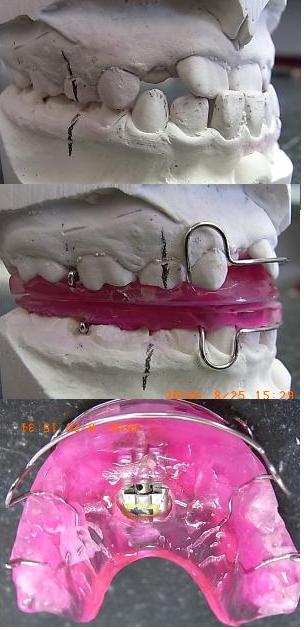
Class 3 activator
The
well-proven type of this robust appliance shown here is
horizontally divided. A specialized screw element connects upper
and lower part. It is somewhat bulky, but provides a successive
lower backshift. Thus, it guides the lower jaw little by little to
a normal bite, if the upper jaw is already well-shaped.
The
example here has a class III occlusion, whereas the deviation of
the midline is just due to migration of the upper incisors and not
caused by lateral bite deviation.
In contrast to the
above-shown bite back-shift plate, which is not as robust and
which requires more specialized parts, this class III activator
cannot provide upper expansion. However, it may be well-suited to
continue a treatment after class III plates have shaped matching
arches, but not yet normalized the jaw positions.
Special upper expansion screws are available for standard activators,
which can also be crafted for lower back-shift, but not a
re-adjustable.
Frontally open class III activators with
palatinal expansion screw and lip shields are used in combination
with physiotherapy in a university in Thailand (see sources) to
treat unselected class III patients successfully. More severe
cases simply received in the course of their treatment a second or
third specimen of this light appliance, which lacks an adjustable
backshift.
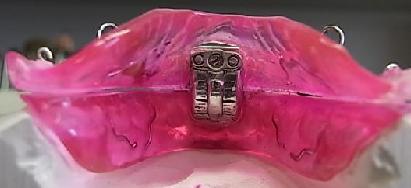
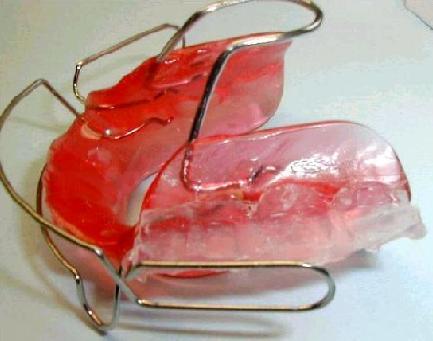
Improved bionators of 2 types
These are improved to stimulate jaw movements (chewing gum effect) and to convert their force to bite corrections. By this, even a treatment of children beyond their growth maximum remains promising.
Silicone rubber is added on the sides of the first (upper) specimen, for more efficient correction of an open bite.
The second specimen is a „reverse“ Bionator modification, for class 3 treatment (back shift of lower jaw). Correction is enhanced here by silicone rubber for a full-contact forward shift of the upper front (set-up technique).
The general shape of Bionators is intended to correct lip and tongue functions, and like all 1-piece appliances, to enhance nose breathing. Correct functions should lead to correct jaw development.
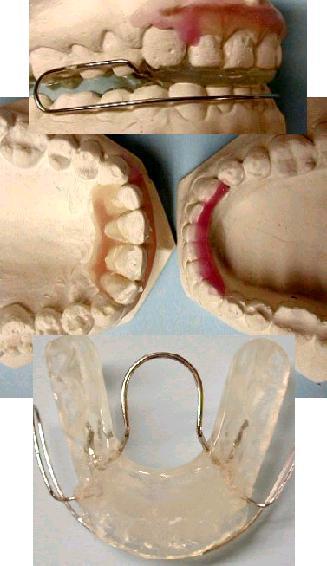
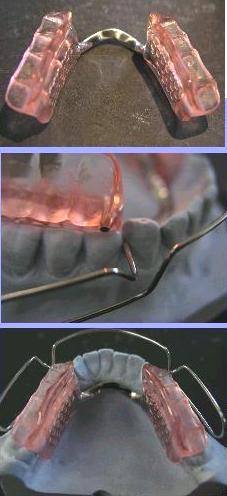
The Biognathor, a functional appliance for adults
The Biognathor is a
double-decker appliance that has been reduced to the essential,
and this is made in high quality for longtime treatment. It is
well-suited to be worn at work, because frontally open, and the
surrounding wire element, which was taken from Balters´ bionator,
can here be detached. For
an overview with 9 more images click here [266kB pdf].
It
alleviates bruxing, jaw joint disorders and tense muscles caused
by this especially under stress. In contrast to common splints, it
does not snap in, but teaches a reflex of release, which already
brings relief.
Moreover, it helps against those malfunctions
which are associated with improper development and ripening of the
orofacial system, like wrong swallowing, mouth breathing or poor
posture of the lips or lower jaw.
The Biognathor can also aim to
achieve a functional bite shift, which is done by influencing the
jaw development, even in adult treatment. This is vehemently
doubted by protagonists of jaw surgery, whereas manufacturers and
protagonists of Herbst appliances and likewise fetters
nevertheless advertise their success in adult treatment.
Indeed,
adult bone comprises some degradation and fresh formation of bone
material. Form follows function.
For any application of the
Biognathor, its effect should be amplified by physiotherapy.
Individually selected exercises with simple items according to
Padovan, Brazil, have been proven successful here.
A likewise
amplification of uncomplicated, rigid functional appliances by
well-targeted daily exercises was reported in Thailand. There,
unselected patients in the age of 7 to 15 (!) yr were cured from
progenic bite, which is particularly widespread in this
population, by 6 to 24 months of this economic treatment.
Guided
self-treatment is also among the various appliances with chewing
gum effect which are displayed in this chapter. They stimulate
muscular exercise by themselves, but this is less specific and
rather in the sense of general stimulation of jaw development and
nose breathing.
It is true that functional bite shift in adults
has no 100% expectancy of success. But on the other hand, since
such appliances as the comfortable Biognathor cause neither pain
nor risk, the attempt should not be excluded in advance. More
research on this field would be desirable.
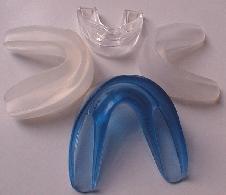
Muscle force jaw shaper, unbreakable
Prefabricated appliance that uses strong chewing-gum effect, as described under
Dentosophie.
By this, it is not only well-suited and economic for early and interceptive
treatment, but can also make the teeth of severe and late cases move.
Can be purchased through me (see main menu, right column) and exists
in 4 shapes with continuous sizes, against
(1) lack of space with
normal or backward jaw position
(2) covered bite (3) lower jaw
too much forward
(4) upper jaw too narrow (unavailable from
other manufacturers).
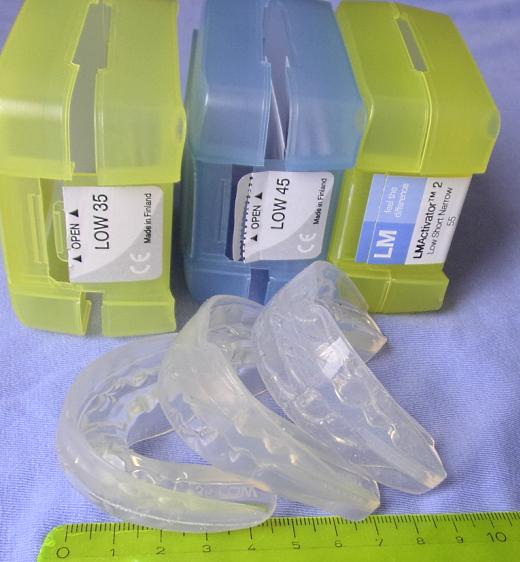
The LM Activator (Finland), a shaper guiding the canine teeth, against sagittal (lateral) crowding
The LM Activator, made of silicone rubber, is a shaper which is
outstanding by its lateral pairs of pockets, which guide the eyeteeth and the bicuspids. These are intended
to prevent, or even to reverse that frequent type of dental crowding which comes from forward migration of the side teeth.
It is mainly designed for children and adolescents, and allows an inexpensive non-retractive treatment of lateral crowding, in contrast
to common orthodontic procedures for this malocclusion. With 8 sizes, all available in 2 lenghts and in 2 thicknesses of the bite plane (the thicker
ones for long-face patients), the LM activator enhances jaw development, if the size is well chosen. Moreover, frontally reinforced specimens are
available, and all types also in extra-large „kingsize“ width (originally aimed at Asian children). In addition, a few trainers for milk dentition
are available, and a one-size-for-all trainer for braces.
The size of the LM activator is measured as the targetted width of the upper and lower incisor sections.
The photos exemplify the sizes 35 (short), 45 (long) and 55 (short), all in normal thickness.
https://lm-dental.com/products/orthodontic-appliances/ shows more images and an instruction how to take the size in cases with and without crowding incisors.
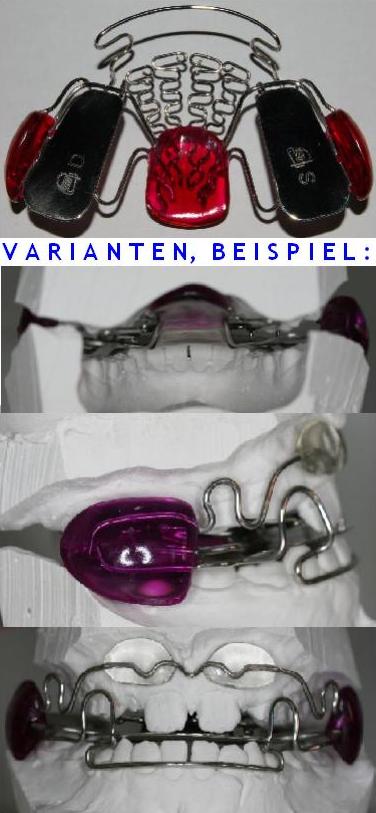
Bracco´s function generating bite of Turin
The
series of function generating bite appliances (FGBs) marks a progress in chewing-gum effect
orofacial orthopedics. Such appliances (see also Muscle force jaw shaper, and Bimler) require just little
daytime wear, which in favour of those children who are rarely at
home during daytime.
FGBs don´t break easily and remain usable while milk teeth are
replacing. They are hygienic, quite comfortable and are intended for early treatment (from 3
years on) and for interceptive treatment in mixed dentition.
Patients with a covered bite can still profit in permanent
dentition from appropriate FGBs which allow to tap muscular forces
for dental alignment.
The school of Turin (Torino) has developped an old type of appliance further, which had survived somewhere in southern Europe, and diversified it to the FGBs and analyzes their muscular effects.
Already a basic kind of FGB cures unilateral crossbite (due to narrow upper jaw) in 7- to 10-yr children rather quickly and painlessly. Moreover, it normalizes the chewing movements on this side, for both hard and soft samples. In contrast to this holistic effect, orthodontists in USA (2001) found no reduction of odd chewing patterns when unilateral crossbite was early treated with rapid maxillary expansion.
The
basic FGB leaves the lower jaw free. 1 Pair of side springs for
support and expansion and 1 pair of wing carriers emerge from its
central body. The wings consist of outer plastic bodies and thin
metal sheets out of special resilient steel, which can be chewed:
chewing-gum effect in durable, hygienic material. In resting
position, neither these lateral planes should touch the teeth, nor
the central body should touch the palate. Instead, the resilient
appliance is held by the tongue against the inside of the upper
arch. Frontally, the wing bodies are connected by at least an
upper or a lower bow. This can have special bendings, if required,
as in the red specimen shown here, which has 4 sturdy protrusion
springs (for pushing) in addition to the basic elements.
The
specimen shown next is a type of a class 3 FGB, since its frontal
elements resemble those of Fränkel´s function regulator 3. In
addition, it has a frontal bite plane, which emerges from the
central body and is rather part of appliances against deep bite or
covered bite (FGB-D). There, it can even be double, for severe
cases.
Against class 2 malocclusions, FGBs are equipped with
lower lip shields or tongue lifters. Thus, the jaw is guided to
its healthy position without lasting force on teeth. In special
cases, the lateral planes can be inclined or bent, to stimulate
those particular muscles which act against the particular
unhealthy jaw development, e.g. a bad vertical face growth,
without any need for hard methods.
The healing effect of FGBs includes also the jaw joints, and they appear favorable to create growth for the wisdom teeth. But since they neither can carry screws nor interdental springs, they cannot open or close gaps orthodontically. In case of gaps of lacking permanent teeth, FGBs at early time favour the close up of the teeth from behind. Aligners can be used if dental alignment is desired after FGB treatment.
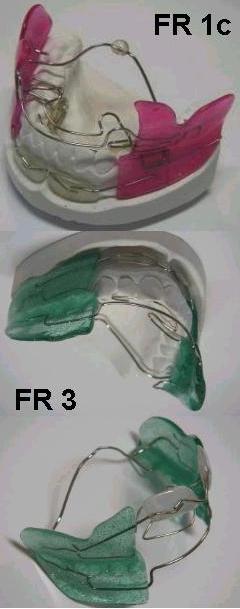
A
shoe tree in the cheeks:
Fränkel´s function regulators 1 and
2
Between lips
and teeth, our cheeks have quite large pockets. The plastic of the
Fränkel appliances reaches into these pockets, up to their top
and bottom. There, it stands 2-3 mm away from the jaw. By this, it
makes our flesh pull at our jawbones. This stimulates their
growth, depending on age of the patient, but even for difficult
„vertical“ face growth. With neither risk of over-correction
and subsequent relapse, nor risk of jaw joint damages or tooth
damages. High longtime stability of the results has been reported.
If treatment begins early, then not only expansions of up to 6 mm
and stretching of the jaws and vertical correction can be
achieved, but also space for the wisdom teeth can be created.
The
small, frontal plastic shields of the Fränkel appliances are
re-adjustable in their distance. So if the growing jaw has
approached them, growth stimulation can be re-activated.
Function regulator 3
The FR3 is well-proven for
treatment of class 3 (progenic) children. Few cases, however, are
better addressed by appliances with chewing-gum effect. It stretches and widens only the
upper jaw, where re-adjustment of the frontal shields is also
possible. It holds the lower jaw back and hinders its growth
(plastic fits tightly around it).
Note well that the space for
the tongue is not reduced, which allows a development of a healty
tongue function.
A Fränkel appliance alone can help a child with jaw disorders to
grow a healthy mouth for whole life.
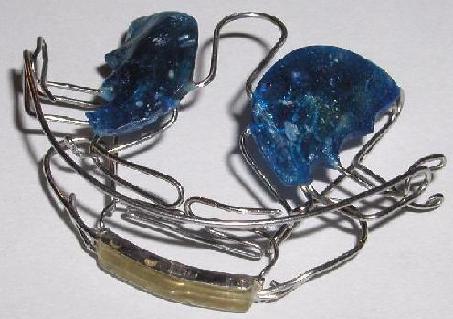
Bimler
appliances(find
more details under „expl. of cases“)
Bimler A = basic type
(for class I and II-1)
Bimler
appliances are designed in 3 types, with several sub-types of
each. All are constructed to be springy such that they encourage
the patient to jaw movements, like a chewing gum does: the
so-called chewing gum effect.
Bimler appliances convert this muscular force not just in
unspecific stimulation of jaw growth, but can be equipped to
direct some force to individual teeth to correct their positions
(see more in the
case examples).
Just
2 strong wires hold the lower part of the Bimler appliances. They
come out of the rear of the upper part , and if a bite shift is
required, they can be bent forward stepwisely. For narrow jaws,
the appliances are equipped with an expansion screw instead of the
upper omega-shaped palatinal spring.
For Bimler treatment of children, the Bimler-A type is appropriate in 90% of these cases. The specimen shown here has an additional pair of springs in the upper cuspid region.
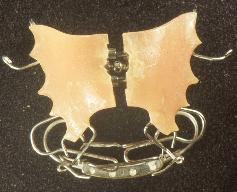
Bimler B appliance, against „covered bite“ (class II-2)
viewed from above, so that
the two long wires which hold the lower frontal part are
underneath it.
Converts the force of biting down to press the
upper and lower incisors into the bone (intrusion), along with
some uprighting of the uppers. By this, the vertical overbite is
reduced, painlessly and also in adults, which was practised e.g.
in the former German Democratic Republic. Likewise, the type against covered
bite among Bracco´s above-mentioned Turin appliances is still suitable for adults.
For courses, pre-fabs and documentation, see http://www.bimler.com/.
Addresses of manufacturers of custom-made Bimler appliances can also be obtained there.
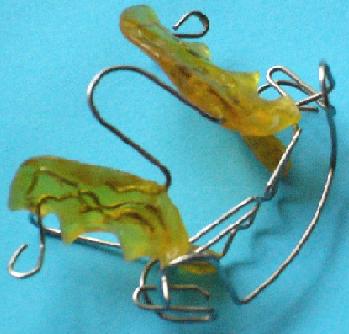
Bimler C / progenic appliance (for class III cases)
5%
of the European population have a more or less progenic bite. The
Bimler C appliance, here viewed from above (find more in the
case example),
leaves for the tongue almost as much space as the above-mentioned
FR 3 does, but is much less bulky in the cheeks and needs less of
daily wearing time. In fact, daytime wear is only required at the
beginning of the treatment.
By this, the Bimler C appliance
allows an inexpensive longtime treatment which does not burden the
patients, but is appropriate to the notorious persistence of
progenic jaw growth. Similar to the before-mentioned lightweight
back-shift plates, the Bimler C is equipped with a downward bow
and with elements to widen nd stretch the upper jaw. Here,
however, these are exclusively powered by jaw movements of the
patients. Further, the Bimler-C screens the tongue from the lower
front teeth, and the complete lower part can stepwisely be bent
backward, if required.
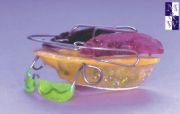
Hangl´s Maxillator
Austrian
appliance which unifies advantages of Karwetzky´s U-bow-activator
in its lower part (simplicity, stability) and of Bimler appliances
in the upper part (gentle lateral and forward expansion by
„chewing gum effect“; open front = low speech hindrance).
The
shown specimen bears additionally an adjustable lower lip bumper,
to overcome a habit of lip sucking. Additional elements can be
included if required. Those of the Bimler technique can be used in
the upper part, whereas the lower part can be machined to allow
e.g. in case of deep bite that the side teeth can grow in plane in
a position where they match properly with the upper.
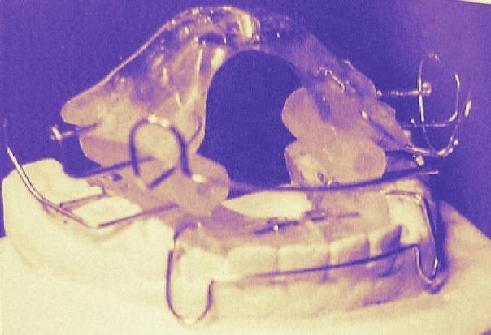
Stockfisch´s Kinetor
This old pioneer appliance is built from a pre-fabricated kit of replacable wire and tubing parts. It has a similar mode of action than the Bimlers, but is narrower inside. It stimulates chewing and demands moderate wear times (night + 2-3 hours per day). Jaw development can be influenced rapidly in 3 dimensions.